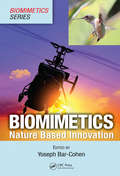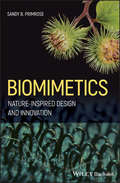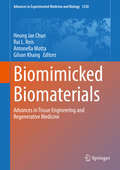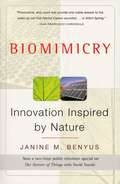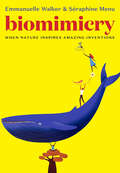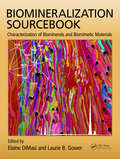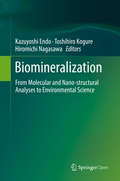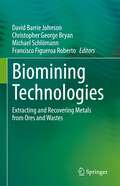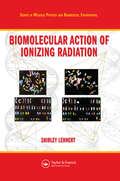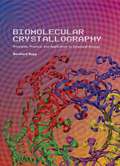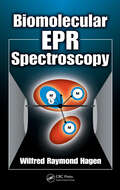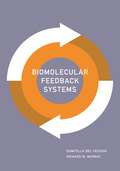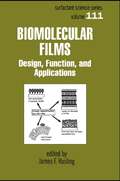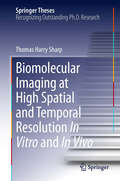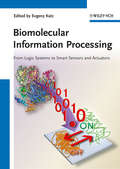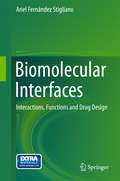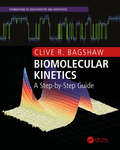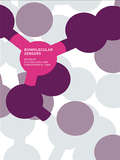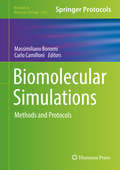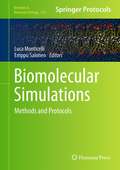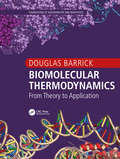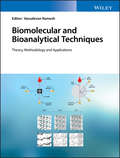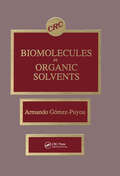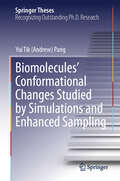- Table View
- List View
Biomimetics: Nature-Based Innovation (Biomimetics Series)
by Yoseph Bar-CohenMimicking nature - from science fiction to engineering realityHumans have always looked to nature's inventions as a source of inspiration. The observation of flying birds and insects leads to innovations in aeronautics. Collision avoidance sensors mimic the whiskers of rodents. Optimization algorithms are based on survival of the fittest, the seed-
Biomimetics: Nature-Inspired Design and Innovation
by Sandy B. PrimroseProvides a professional, contemporary, and concise review of the current knowledge and advances in biomimetics This book covers the field of biomimicry, an area of science where researchers look to mimic aspects of plants or animals in order to solve problems in aerospace, shipping, building, electronics, and optics, among others. It presents the latest developments in biomimicry and gives readers sufficient grounding to help them understand the current, and sometimes technically complex, research literature. Different themes are covered throughout and text boxes deal with the relevant physics for readers who may lack this knowledge. Biomimetics: Nature-Inspired Design and Innovation examines issues in fluid dynamics such as avoiding sonic booms, reducing train noise, increasing wind turbine efficiency, and more. Next, it looks at optical applications, e.g. how nature generates color without dyes and pigment, and how animals stay cool in desert environments. A chapter on the built environment discusses cooling systems for buildings based on termite mounds; creating self-cleaning paint based on lotus leaves; unobtrusive solar panels based on ivy; and buildings that respond to the environment. Two more sections focus on biomimicry for the creation of smart materials and smart devices. The book finishes with a look at the field’s future over the next decade. Presents each topic in sufficient detail in order to enable the reader to comprehend the original scientific papers Emphasizes those examples of biomimicry that have made it into products Features text boxes that provide information on the relevant physics or engineering principles for biologists who do not have a physics background Covers the scientific literature up to July 2019 Biomimetics: Nature-Inspired Design and Innovation is an excellent book for senior undergraduates and post-graduate students in the life sciences, material sciences, and bioengineering. It will also appeal to lay readers with an interest in nature as well as scientists in general.
Biomimicked Biomaterials: Advances in Tissue Engineering and Regenerative Medicine (Advances in Experimental Medicine and Biology #1250)
by Rui L. Reis Heung Jae Chun Gilson Khang Antonella MottaThis book is the second of two volumes that together offer a comprehensive account of cutting-edge advances in the development of biomaterials for use within tissue engineering and regenerative medicine. In this volume, which is devoted to biomimetic biomaterials, the opening section discusses bone regeneration by means of duck’s feet-derived collagen scaffold and the use of decellularized extracellular matrices. The role of various novel biomimetic hydrogels in regenerative medicine is then considered in detail. The third section focuses on the control of stem cell fate by biomimetic biomaterials, covering exosome-integrated biomaterials for bone regeneration, cellular responses to materials for biomedical engineering, and the regulation of stem cell functions by micropatterned structures. Finally, the use of nano-intelligent biocomposites in regenerative medicine is addressed, with discussion of, for example, recent advances in biphasic calcium phosphate bioceramics and blood-contacting polymeric biomaterials. The authors are recognized experts in the interdisciplinary field of regenerative medicine and the book will be of value for all with an interest in regenerative medicine based on biomaterials.
Biomimicry
by Janine M. BenyusThis profound and accessible book details how science is studying nature's best ideas to solve our toughest 21st-century problems. If chaos theory transformed our view of the universe, biomimicry is transforming our life on Earth. Biomimicry is innovation inspired by nature - taking advantage of evolution's 3.8 billion years of R&D since the first bacteria. Biomimics study nature's best ideas: photosynthesis, brain power, and shells - and adapt them for human use. They are revolutionising how we invent, compute, heal ourselves, harness energy, repair the environment, and feed the world. Science writer and lecturer Janine Benyus names and explains this phenomenon. She takes us into the lab and out in the field with cutting-edge researchers as they stir vats of proteins to unleash their computing power; analyse how electrons zipping around a leaf cell convert sunlight into fuel in trillionths of a second; discover miracle drugs by watching what chimps eat when they're sick; study the hardy prairie as a model for low-maintenance agriculture; and more.
Biomimicry: When Nature Inspires Amazing Inventions
by Seraphine MenuNature did it first! A beautiful and whimsically illustrated explanation of cool inventions like Velcro and scuba suits that were inspired by the natural worldDiscover how bats led to the development of radar, whales inspired the pacemaker, and the lotus flower may help us produce indestructible clothing. "Biomimicry" comes from the Greek "bio" (life) and "mimesis" (imitation)." Here are various and amazing ways that nature inspires us to create cool inventions in science and medicine, clothing design, and architecture. From the fireflies that showed inventors how LEDs could give off more light to the burdock plant that inspired velcro to the high speed trains of Japan that take the form of a kingfisher's sleek, aerodynamic head, there are innumerable ways that we can create smarter, better, safer inventions by observing the natural world. Author Seraphine Menu and illustrator Emmanuelle Walker also gently explain that our extraordinary, diverse, and awe-inspiring world is like a carefully calibrated machine and its fragile balance must be treated with extreme care and respect. "Go outside," they say, "observe, compare, and maybe some day you'll be the next person to be struck by a great idea."
Biomineralization Sourcebook: Characterization of Biominerals and Biomimetic Materials
by Laurie B. Gower Elaine DiMasiWhat does it mean to be at the forefront of a characterization technique? Novel implementation and research, finding new ways to visualize composites, and new techniques all play a role. Yet with the myriad of advances in the field, keeping up with new and advanced techniques, often from many different areas, has become a challenge. Biomineralizati
Biomineralization: From Molecular and Nano-structural Analyses to Environmental Science
by Kazuyoshi Endo Toshihiro Kogure Hiromichi NagasawaThis open access book is the proceedings of the 14th International Symposium on Biomineralization (BIOMIN XIV) held in 2017 at Tsukuba. Over the past 45 years, biomineralization research has unveiled details of the characteristics of the nano-structure of various biominerals; the formation mechanism of this nano-structure, including the initial stage of crystallization; and the function of organic matrices in biominerals, and this knowledge has been applied to dental, medical, pharmaceutical, materials, agricultural and environmental sciences and paleontology. As such, biomineralization is an important interdisciplinary research area, and further advances are expected in both fundamental and applied research.
Biomining Technologies: Extracting and Recovering Metals from Ores and Wastes
by Michael Schlömann David Barrie Johnson Christopher George Bryan Francisco Figueroa RobertoThis book describes emerging and established industrial processes of biomining technologies used for the recovery of metals of economic interest from, e.g. mineral ores, mining and electronic wastes using microbiological technologies. Multiple chapters focus on engineering design and operation of biomining systems. Several industrial case studies from China, Chile, Peru, Russia/Kazakhstan and Finland are included, which emphasises the practical approach of the book. The reader not only learns more about the biology, diversity and ecology of microorganisms involved in biomining processes, but also about microbial biomolecular and cultivation tools used in the biomining industry. Special emphasis is put on emerging biotechnologies enabling the use of biomining for recycling metals from e-wastes, waste streams and process waters. Finally, the future impacts and direction of biomining towards sustainability in a metal-demanding world are also highlighted.The book is aimed at an interdisciplinary audience involving operators and researchers working across disciplines including geology, chemical engineering, microbiology and molecular biology. This is reflected by the content of this book, as well as by its authors, who are all leading practitioners and authorities in their fields.
Biomolecular Action of Ionizing Radiation (Series in Medical Physics and Biomedical Engineering)
by Shirley LehnertEmbracing the transformation of radiation sciences by the recent surge of developments in molecular biology, this progressive text offers an up-to-date analysis of in vitro and in vivo molecular responses in the body induced by ionizing radiation. With a unique emphasis on medical physics applications, Biomolecular Action of Ionizi
Biomolecular Crystallography: Principles, Practice, and Application to Structural Biology
by Bernhard RuppSynthesizing over thirty years of advances into a comprehensive textbook, Biomolecular Crystallography describes the fundamentals, practices, and applications of protein crystallography. Illustrated in full-color by the author, the text describes mathematical and physical concepts in accessible and accurate language. Biomolecular Crystallography will be a valuable resource for advanced undergraduate and graduate students and practitioners in structural biology, crystallography, and structural bioinformatics.
Biomolecular EPR Spectroscopy
by Wilfred Raymond HagenComprehensive, Up-to-Date Coverage of Spectroscopy Theory and its Applications to Biological SystemsAlthough a multitude of books have been published about spectroscopy, most of them only occasionally refer to biological systems and the specific problems of biomolecular EPR (bioEPR). Biomolecular EPR Spectroscopy provides a practical introduction t
Biomolecular Feedback Systems
by Richard Murray Domitilla Del VecchioThis book provides an accessible introduction to the principles and tools for modeling, analyzing, and synthesizing biomolecular systems. It begins with modeling tools such as reaction-rate equations, reduced-order models, stochastic models, and specific models of important core processes. It then describes in detail the control and dynamical systems tools used to analyze these models. These include tools for analyzing stability of equilibria, limit cycles, robustness, and parameter uncertainty. Modeling and analysis techniques are then applied to design examples from both natural systems and synthetic biomolecular circuits. In addition, this comprehensive book addresses the problem of modular composition of synthetic circuits, the tools for analyzing the extent of modularity, and the design techniques for ensuring modular behavior. It also looks at design trade-offs, focusing on perturbations due to noise and competition for shared cellular resources.Featuring numerous exercises and illustrations throughout, Biomolecular Feedback Systems is the ideal textbook for advanced undergraduates and graduate students. For researchers, it can also serve as a self-contained reference on the feedback control techniques that can be applied to biomolecular systems.Provides a user-friendly introduction to essential concepts, tools, and applicationsCovers the most commonly used modeling methodsAddresses the modular design problem for biomolecular systemsUses design examples from both natural systems and synthetic circuitsSolutions manual (available only to professors at press.princeton.edu)An online illustration package is available to professors at press.princeton.edu
Biomolecular Films: Design, Function, and Applications (Surfactant Science Ser. #111)
by James F. RuslingThis text examines films of biomolecules that can provide solid surfaces for catalyzing enzyme reactions, serve in biosensors and as biorecognition elements, mediate nanoparticle formation, and provide a basis for fundamental studies and applications in biomedicine and biomedical devices.
Biomolecular Imaging at High Spatial and Temporal Resolution In Vitro and In Vivo (Springer Theses)
by Thomas Harry SharpAs part of a collaboration between two different groups in chemistry and biochemistry, Thom Sharp presents here his thesis work on the development of new methods for cryoelectron microscopy. Throughout his Ph. D. , Thom had to master a whole range of techniques including modelling, molecular biology and microscopy. Using these skills to tackle an outstanding problem, the pursuit of high-resolution structures of peptide-based materials, Thom highlights in this thesis his newly developed methods for analysing and processing this particular type of electron microscopy data. This thesis gives the first molecular description of a de-novo designed peptide-based material. In general, this research will have a huge impact on the peptide assembly field, and also in electron microscopy as it introduces new methods and approaches, all of which are Thom's inventions and are described in this thesis.
Biomolecular Information Processing
by Evgeny KatzEdited by a renowned and much cited chemist, this book covers the whole span of molecular computers that are based on biomolecules. The contributions by all the major scientists in the field provide an excellent overview of the latest developments in this rapidly expanding area. A must-have for all researchers working on this very hot topic. Perfectly complements Molecular and Supramolecular Information Processing, also by Prof. Katz, and available as a two-volume set.
Biomolecular Interfaces: Interactions, Functions and Drug Design
by Ariel Fernández StiglianoThe book focuses on the aqueous interface of biomolecules, a vital yet overlooked area of biophysical research. Most biological phenomena cannot be fully understood at the molecular level without considering interfacial behavior. The author presents conceptual advances in molecular biophysics that herald the advent of a new discipline, epistructural biology, centered on the interactions of water and bio molecular structures across the interface. The author introduces powerful theoretical and computational resources in order to address fundamental topics such as protein folding, the physico-chemical basis of enzyme catalysis and protein associations. On the basis of this information, a multi-disciplinary approach is used to engineer therapeutic drugs and to allow substantive advances in targeted molecular medicine. This book will be of interest to scientists, students and practitioners in the fields of chemistry, biophysics and biomedical engineering.
Biomolecular Kinetics: A Step-by-Step Guide (Foundations of Biochemistry and Biophysics)
by Clive R. Bagshaw"a gem of a textbook which manages to produce a genuinely fresh, concise yet comprehensive guide"–Mark Leake, University of York "destined to become a standard reference…. Not just a ‘how to’ handbook but also an accessible primer in the essentials of kinetic theory and practice."–Michael Geeves, University of Kent "covers the entire spectrum of approaches, from the traditional steady state methods to a thorough account of transient kinetics and rapid reaction techniques, and then on to the new single molecule techniques" –Stephen Halford, University of Bristol This illustrated treatment explains the methods used for measuring how much a reaction gets speeded up, as well as the framework for solving problems such as ligand binding and macromolecular folding, using the step-by-step approach of numerical integration. It is a thoroughly modern text, reflecting the recent ability to observe reactions at the single-molecule level, as well as advances in microfluidics which have given rise to femtoscale studies. Kinetics is more important now than ever, and this book is a vibrant and approachable entry for anyone who wants to understand mechanism using transient or single molecule kinetics without getting bogged down in advanced mathematics. Clive R. Bagshaw is Emeritus Professor at the University of Leicester, U.K., and Research Associate at the University of California at Santa Cruz, U.S.A.
Biomolecular Sensors
by Christopher R. Lowe Electra GizeliThe development of devices that incorporate biological assemblies is impacting analytical and biomedical research. Today, scientists can monitor vital biological interactions-such as the binding of DNA to proteins-in real time, deriving unique information necessary to understanding biochemical pathways and thus aiding the design of drugs to regulat
Biomolecular Simulations: Methods and Protocols (Methods in Molecular Biology #2022)
by Massimiliano Bonomi Carlo CamilloniThis volume explores the recent advancements in biomolecular simulations of proteins, small molecules, and nucleic acids, with a primary focus on classical molecular dynamics (MD) simulations at atomistic, coarse-grained, and quantum/ab-initio levels. The chapters in this book are divided into four parts: Part One looks at recent techniques used in the development of physic-chemical models of proteins, small molecules, nucleic acids, and lipids; Part Two discusses enhanced sampling and free-energy calculations; Part Three talks about integrative computational and experimental approaches for biomolecular simulations; and Part Four focuses on analyzing, visualizing, and comparing biomolecular simulations. Written in the highly successful Methods in Molecular Biology series format, chapters include introductions to their respective topics, lists of the necessary materials and reagents, step-by-step, readily reproducible laboratory protocols, and tips on troubleshooting and avoiding known pitfalls. Cutting-edge and comprehensive, Biomolecular Simulations: Methods and Protocols is a valuable resource for both novice and expert researchers who are interested in studying different areas of biomolecular simulations, and discovering new tools to progress their future projects.
Biomolecular Simulations: Methods and Protocols (Methods in Molecular Biology #924)
by Emppu Salonen Luca MonticelliOver the past 40 years the field of molecular simulations has evolved from picosecond studies of isolated macromolecules in vacuum to studies of complex, chemically heterogeneous biological systems consisting of millions of atoms, with the simulation time scales spanning up to milliseconds. In Biomolecular Simulations: Methods and Protocols, expert researchers illustrate many of the methods commonly used in molecular modelling of biological systems, including methods for electronic structure calculations, classical molecular dynamics simulations and coarse-grained techniques. A selection of advanced techniques and recent methodological developments, which rarely find coverage in traditional textbooks, is also introduced. Written in the highly successful Methods in Molecular Biology series format, chapters include general introductions to well-established computational methodologies, applications to real-world biological systems, as well as practical tips and general protocols on carrying out biomolecular simulations. Special emphasis is placed on simulations of proteins, lipids, nucleic acids, and carbohydrates. Authoritative and practical, Biomolecular Simulations: Methods and Protocols seeks to aid scientists in further simulation studies of biological systems.
Biomolecular Thermodynamics: From Theory to Application (Foundations of Biochemistry and Biophysics)
by Douglas Barrick"an impressive text that addresses a glaring gap in the teaching of physical chemistry, being specifically focused on biologically-relevant systems along with a practical focus…. the ample problems and tutorials throughout are much appreciated." –Tobin R. Sosnick, Professor and Chair of Biochemistry and Molecular Biology, University of Chicago "Presents both the concepts and equations associated with statistical thermodynamics in a unique way that is at visual, intuitive, and rigorous. This approach will greatly benefit students at all levels." –Vijay S. Pande, Henry Dreyfus Professor of Chemistry, Stanford University "a masterful tour de force…. Barrick's rigor and scholarship come through in every chapter."–Rohit V. Pappu, Edwin H. Murty Professor of Engineering, Washington University in St. Louis This book provides a comprehensive, contemporary introduction to developing a quantitative understanding of how biological macromolecules behave using classical and statistical thermodynamics. The author focuses on practical skills needed to apply the underlying equations in real life examples. The text develops mechanistic models, showing how they connect to thermodynamic observables, presenting simulations of thermodynamic behavior, and analyzing experimental data. The reader is presented with plenty of exercises and problems to facilitate hands-on learning through mathematical simulation. Douglas E. Barrick is a professor in the Department of Biophysics at Johns Hopkins University. He earned his Ph.D. in biochemistry from Stanford University, and a Ph.D. in biophysics and structural biology from the University of Oregon.
Biomolecular and Bioanalytical Techniques: Theory, Methodology and Applications
by Vasudevan RameshAn essential guide to biomolecular and bioanalytical techniques and their applications Biomolecular and Bioanalytical Techniques offers an introduction to, and a basic understanding of, a wide range of biophysical techniques. The text takes an interdisciplinary approach with contributions from a panel of distinguished experts. With a focus on research, the text comprehensively covers a broad selection of topics drawn from contemporary research in the fields of chemistry and biology. Each of the internationally reputed authors has contributed a single chapter on a specific technique. The chapters cover the specific technique’s background, theory, principles, technique, methodology, protocol and applications. The text explores the use of a variety of analytical tools to characterise biological samples. The contributors explain how to identify and quantify biochemically important molecules, including small molecules as well as biological macromolecules such as enzymes, antibodies, proteins, peptides and nucleic acids. This book is filled with essential knowledge and explores the skills needed to carry out the research and development roles in academic and industrial laboratories. A technique-focused book that bridges the gap between an introductory text and a book on advanced research methods Provides the necessary background and skills needed to advance the research methods Features a structured approach within each chapter Demonstrates an interdisciplinary approach that serves to develop independent thinking Written for students in chemistry, biological, medical, pharmaceutical, forensic and biophysical sciences, Biomolecular and Bioanalytical Techniques is an in-depth review of the most current biomolecular and bioanalytical techniques in the field.
Biomolecules in Organic Solvents
by Armando Gomez-PuyouBiomolecules and Organic Solvents discusses the behavior of enzymes and multi-enzyme complexes in organic solvents, in addition to the problem of water-protein interactions and the characteristics of water at interphases. It attempts to bridge the gap between the all water and the organic solvents systems from the point of view of enzyme structure and function. The mechanism of action of enzymes dispersed in anhydrous organic solvents and the biotechnological perspectives of the field are evaluated, and new information regarding the function and characteristics of complex multi-enzymatic systems and whole cells in organic solvents are examined. New developments regarding the nature of the water pool and interphases of reverse micelles and their enzyme kinetics are also explored. The characteristics and properties of enzymes trapped in reverse micelles are discussed throughout the book. Biomolecules in Organic Solvents is essential reading for biochemists, molecular biologists, and others working in related fields.
Biomolecules' Conformational Changes Studied by Simulations and Enhanced Sampling (Springer Theses)
by Yui Tik PangThis thesis illuminates the critical roles biomolecules, from small molecules to proteins, play in cellular functionality, particularly highlighting their conformational changes in response to environmental cues or binding events—a cornerstone concept in drug design as well as the manifestations of disease. It explores the conformational flexibility of small molecules and proteins, essential for predicting drug interactions and understanding biological processes. Through advanced molecular dynamics simulations and enhanced sampling techniques, this research offers unprecedented insights into the structural dynamics of three distinct biomolecular systems: the capsid assembly modulator AT130, the passenger domain of pertactin, and the SARS-CoV-2 spike protein. Each system represents a unique facet of biological complexity, underscoring the thesis's contribution to our understanding of biomolecular behavior across various scales. Furthermore, the thesis advances the field by updating the Force Field Toolkit for improved simulation accuracy. This work not only showcases the adaptability and importance of simulation techniques in modern biological research but also paves the way for novel therapeutic strategies by deepening our understanding of biomolecular dynamics.
